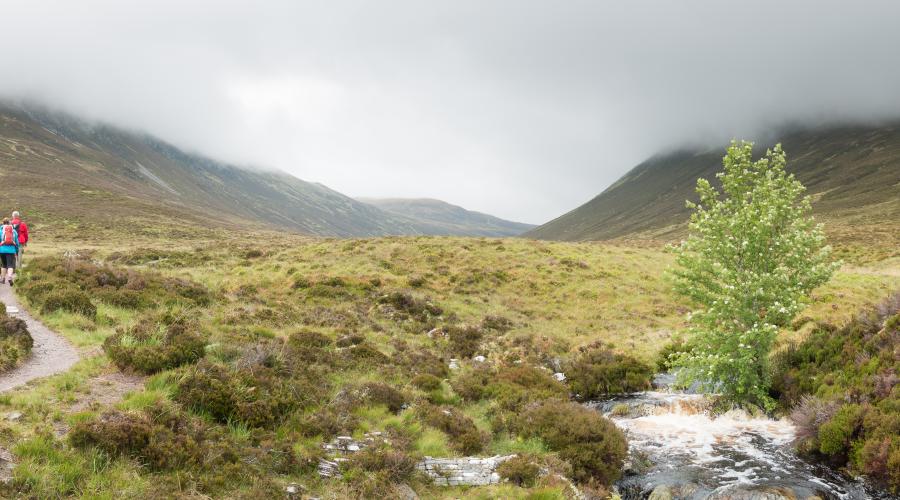
Ben Wyvis NNR - Visiting the reserve
Visit Ben Wyvis NNR for spectacular Highland views and unique upland habitats.
Ben Wyvis stands proudly alone, commanding the skyline of the inner Moray Firth. This is a well-known and popular 'Munro' climb up to the whaleback ridge, which supports a carpet of fragile moss heath and an internationally important population of breeding dotterel. These breeding birds can be easily disturbed and so we ask walkers to keep their dogs in sight and under close control (ideally on a lead) especially on the summit plateau during the summer (April - August).
Walking the summit ridge is like stepping on a deep-pile carpet. Stretching for almost a mile, this carpet is the UK's largest area of woolly hair-moss. Mosses are easily damaged by trampling, so keeping to the centre of the main path helps to preserve this precious habitat.
Getting here
Ben Wyvis NNR is just off the road between Garve and Ullapool, easily accessible from the Highland capital of Inverness.
By car
Approach Ben Wyvis NNR from the car park at Garbat on the A835 between Garve and Ullapool. The grid reference is NH 410 671.
IV23 2PG is the nearest postcode.
Car parks
The Forest Enterprise Scotland car park at the entrance to the reserve is small and fills up quickly. Please consider car sharing. If the car park is full then there is a layby about 400m along the road (towards Ullapool). Please be considerate with your parking and do not obstruct access for local residents or park on the road verge.
Public transport
The nearest bus stop is in the village of Garve (8 kilometres from the car park). The car park is on the main Ullapool to Inverness route. You may be able to request a stop at Garbat on some services – but please check with the service provider.
The nearest railway station is at Garve (8 kilometres from the car park) on the Inverness to Kyle of Lochalsh line. There is a path from the train station to the reserve.
Map
"Fifteen miles west of Inverness off the A835. The nearest train station is at Garve, four miles away. Buses between Inverness and Ullapool pass this way."
For visitors
Ben Wyvis NNR - visiting the reserve leaflet
Our Visit Ben Wyvis leaflet is a good introduction to the reserve.
Toilets
The nearest toilet is at Silver Bridge, 3 kilometres south on the A835.
Picnic areas
There is a picnic table about 700 metres up the path.
Trails to the summit
Although a popular and relatively easy climb, Ben Wyvis should be treated with respect. The 6.5 kilometre route starts from the car park. The path goes through forestry, and then it heads up to An Cabar and along the summit ridge. The average time to the summit and back is 6 hours.
Check the weather forecast and change your plans if conditions change on the mountain. Make sure you have a map, compass, hillwalking boots and warm, weatherproof clothing, even in summer. There is no shelter at An Cabar or on the ridge.
The most popular route starts from the Forest Enterprise Scotland car park at Garbat on the A835 road between Garve and Ullapool.
Follow the path alongside the Allt a’ Bhealaich Mhor. Aspen, birch and rowan cling to its banks. After 2 kilometres enter the reserve’s landscape of heather and bog plants. The path zig-zags steeply up a staircase of boulders through the scree to An Cabar (946 metres). Take the most direct route along the ridge to the summit, keeping to the centre of the main path to prevent further damage.
Find descriptions and a map of the route in the Visit Ben Wyvis leaflet.
Seasonal highlights
You’re sure to find something of interest all year round at Ben Wyvis.
Spring
The summit of Ben Wyvis is carpeted with grey-green woolly hair moss. Please tread lightly, as this important habitat is easily damaged. You might spot male ptarmigan displaying to their mates and golden eagles soaring above.
Summer
Flocks of dotterel stop by on their way to more northerly breeding sites. Some will stay to breed – the duties of hatching the eggs and tending the young are handed over to the male birds.
On the lower ground the mosses are rich and lush in summer. Butterflies and dragonflies – such as the large red damselfly and golden-ringed dragonfly – are found around burns and pools.
Autumn
On calm days in late October, the mountain resounds with the roaring of red deer stags rutting. In parts of the reserve the heath is dotted with dwarf birch and a mosaic of dwarf shrubs. Colours range from the shiny reds of the cowberry and bearberry to the glossy black of the crowberry and mountain bearberry.
Winter
Winter brings a dusting of snow to the high peaks. You may be lucky enough to spot a ptarmigan in its white winter plumage – or a white mountain hare. On a clear winter’s day the views from the summit are outstanding – the whole of the Moray Firth is spread out beneath you.
Find out more on
- Visiting the reserve leaflet
- About the reserve
- Visit more of our nature reserves
Related Links
- Designation and management of Scotland’s National Nature Reserves
- Learn more about other protected areas





